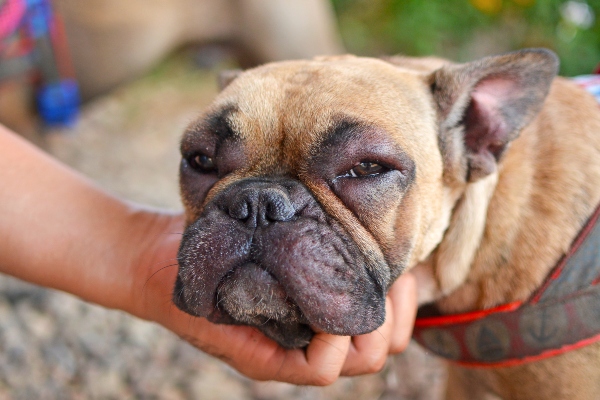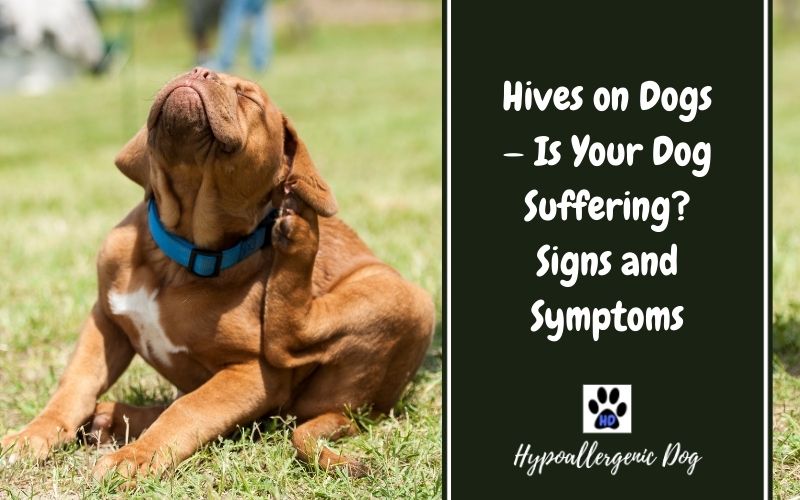
Hives on Dogs — Is It Possible?
In short, yes. Hives on dogs are very real in the canine world. Crossbreeding is the norm these days, so with mixing genetics from various breeds it’s no wonder that our bow-wows are becoming more sensitive to their environment.
Hives are a common dog allergic reaction. They can appear rapidly after your pooch is exposed to the allergen and can make your furry friend very anxious and poorly.
And, while it’s easy to spot on humans, thanks to your tail-wagger’s coat, hives on a dog may not be so obvious.
The medical term for hives in dogs is urticaria. And, if you’ve taken a trip to the vets, you may already be aware of the red bumps on their body. An outbreak can appear anywhere, but the belly, back, face, head and neck are the usual areas — even in some cases, their tongue.
Other common symptoms to look out for are:
- Hair standing straight.
- Breathing difficulties.
- Intense itching.
- Swelling of the face and eyes — severe cases.
Hives on a dog can be caused by exposure to an allergen that your dog has reacted to. Dogs are generally becoming more sensitive to the environment and the food we feed them.
But why?
It’s possible that dogs have always suffered from hives, and thanks to modern science, we now have a medical term for it and can identify the triggers and best treatments.
On the other hand, many believe that it could be because cross-breeding is more popular than ever. Many breeders want to combine the brilliant genetics of two breeds, which is perfectly normal nowadays, but does this create extra sensitive pooches?
We may never know the reason for the increasing trend in dogs displaying symptoms of hives — but here is a list of some common causes:
- Food — With the vast majority of bow-wows being fed commercially produced dog food, it’s not surprising that some dogs develop food intolerances.
- Medicine — Many dogs have issues with certain medicines. Identifying an allergy to medicine can appear with a hives breakout on a dog’s face, head, and back.
- Environmental allergens — Dogs that break out in hives may have come into contact with allergens in the environment. For example, plants, household cleaning products — such as antibacterial sprays or washing powders, even doggy shampoo.
- Insects — When your pooch gets stung or bitten by an insect, they could develop hives as a way of their bodies reacting to the bite/sting.

If you’ve noticed your dog has hives, remember that it’s not usually life-threatening and the bumps should go away on their own accord.
However, if your dog develops noticeable swelling around their face or neck, you should seek professional advice to ensure their airways are not compromised — anaphylaxis is a possibility with insect bites and stings.
What’s more, get them checked out if they have had hives for longer than a day.
Hives can make your dog miserable, but hopefully, it will be short-lived. If you notice a decline in their health or appearance then a vet visit may be required.
Determining the best treatment is identifying the cause. For example, if you suspect a reaction to soap, rinsing your dog with clean warm water may help to remove any residue from their skin and coat.
Should a trip to the vets be in order, they may prescribe antihistamines. If the breakout is severe, your furry friend could need corticosteroids. And, if the hives are present from a suspected food allergy, milk of magnesia may be given to rid your dog’s stomach of the offending food.
Conclusion
To prevent hives — avoiding the problem-causing allergen is the best course of action. If you’re aware of known triggers, then as a doggie parent try to steer clear of any foods/medicines/household products that you suspect are causing an outbreak.
Hives are generally not dangerous, and they may hang around for days or disappear within hours. Hence, try to make your pal as comfortable as possible until the reaction passes.
If left to scratch, your pooch could break the skin and this is where infection can set in. Look at giving a herbal remedy bath such as the ones named above to help relieve the itch of hives on dogs — and make your best friend a happy hound again.

Hives on Dogs FAQs
What Can I Give My Dog for Hives?
Dogs with hives usually respond quickly to treatment. You can offer them an antihistamine and a steroid, or in some severe cases, injectable medication may be needed alongside intravenous fluids.
How Long Do Hives on a Dog Last?
They can last from a few hours to a few days.
What Antihistamine Can I Give My Dog?
Cetirizine (Zyrtec) and loratadine (Claritin) are considered safe for dogs. However, you mustn’t give your dog any medication without checking the dosage with a vet first. Many antihistamines can include decongestants which can cause harm to your dog.
Should I Take My Dog to the Vet if They Have Hives?
Hives are generally not a cause for concern. However, sometimes they can be the start of a more severe reaction. If you notice any puffiness around your dog’s face or eyes you must get them checked over as soon as possible. Swelling can affect your pooch’s airways.
Will Dog Hives Go Away on Their Own?
Hives on dogs very often resolve themselves in just a few hours. However, for more serious cases where the allergen can not immediately be removed, medication may be needed.
Are Dog Hives an Emergency?
Although hives may not be deemed as a life or death emergency, you should take action as soon as possible. Treating the allergen should stop the reaction — and your dog can begin to feel more comfortable.


